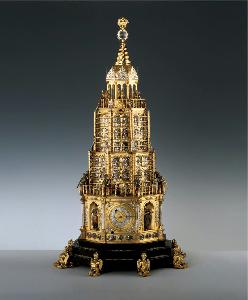Hans Schlotheim, Hans Schlotthammer
Hans Schlotheim, Hans Schlotthammer;Hans Schlottheim
Place: Naumbourg (Saale)
Born: 1547
Death: 1625
Biography:
Early Life and Career
Hans Schlotheim, Hans Schlotthammerwas a German orfèvre, horloger, and mécanicien, born in Naumbourg (Saale) in 1547 and died in Augsbourg in 1625. He is renowned for his intricate horloges automates, which were highly complex mechanical clocks that showcased his exceptional skill as a clockmaker.
Artistic Achievements
Schlotthammer's most notable works include his three variantes of 'galions mécaniques', including the famous nef of Charles Quint. These mechanical clocks were not only functional but also decorative, featuring intricate carvings and ornaments. His work can be found in various museums, including the Green Vault (Dresden, Germany), which houses an impressive collection of his sculptures.
Museum Collections
Some of Schlotthammer's notable works are part of the collections at the Kunstsammlungen Graf von Schönborn Pommersfelden, Germany and the Max-Slevogt Galerie, Germany. These museums offer a glimpse into the artistic genius of Schlotthammer and his contemporaries. For more information on these collections, visit The Museum Collection Hugo Fischer (Bühl, Germany) or Kunstsammlungen Graf von Schönborn Pommersfelden, Germany.
Legacy
Schlotthammer's legacy extends beyond his own works. He obtained the 'droit de forgeron' in Augsbourg in 1573 and became a Meister in 1576, demonstrating his expertise as a master clockmaker. His contributions to the field of horology have inspired generations of artists and craftsmen.
- Hans Schlotheim, Hans Schlotthammer is also known for his great clock on the façade of his house in Augsbourg.
- His work can be found in various museums, including the Green Vault (Dresden, Germany).
- For more information on his life and work, visit Hans Schlotheim, Hans Schlotthammer on Wikioo.org.
Conclusion
Hans Schlotheim, Hans Schlotthammerwas a master of his craft, creating intricate and beautiful horloges automates that continue to inspire wonder today. His legacy can be seen in the many museums and collections that showcase his work, including the Kunstsammlungen Graf von Schönborn Pommersfelden, Germany and the Max-Slevogt Galerie, Germany. For a deeper understanding of his art and contributions to the world of horology, visit The Museum Collection Hugo Fischer (Bühl, Germany) or explore the many resources available on Wikioo.org.

